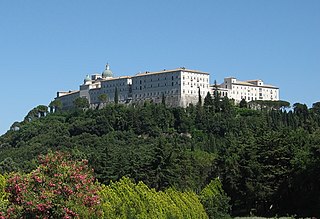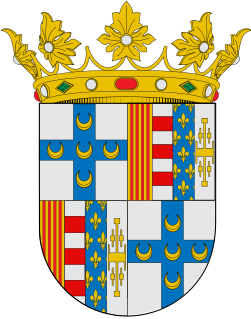Pandulf III was briefly the Prince of Salerno from around 3 to 10 June 1052. He was the eldest of four brothers of Gemma, wife of Prince Guaimar IV. He seized the throne in a coup d'état, when he and his brother assassinated Guaimar. He reigned for only a week before he was forced to step down and was promptly murdered.

Guaimar IV was Prince of Salerno (1027–1052), Duke of Amalfi (1039–1052), Duke of Gaeta (1040–1041), and Prince of Capua (1038–1047) in Southern Italy over the period from 1027 to 1052. He was an important figure in the final phase of Byzantine authority in the Mezzogiorno and the commencement of Norman power. He was, according to Amatus of Montecassino, "more courageous than his father, more generous and more courteous; indeed he possessed all the qualities a layman should have—except that he took an excessive delight in women."
Pandulf was probably a member of the family of the counts of Teano in the Principality of Capua. [1]

Teano is a town and comune in the province of Caserta, Campania, southern Italy, 30 kilometres (19 mi) northwest of Caserta on the main line to Rome from Naples. It stands at the southeast foot of an extinct volcano, Rocca Monfina. Its St. Clement's cathedral is the see of the Roman Catholic Diocese of Teano-Calvi, which started as Diocese of Teano circa AD 300.
The Principality of Capua was a Lombard state centred on Capua in Southern Italy, usually de facto independent, but under the varying suzerainty of Western and Eastern Roman Empires. It was originally a gastaldate, then a county, within the principality of Salerno.
According to Amatus of Montecassino, who is the chief source for the coup of 1052, the first challenge to Guaimar's authority came from the Duchy of Amalfi, which was subject to Guaimar and owed him tribute. In April, Guaimar's representative, Duke Manso II, was forced to flee Amalfi, which began attacking Salernitan shipping. With the revenue from the tribute gone, some of Guaimar's leading men began to waiver in their loyalty. According to Amatus, the leader of the conspiracy to remove Guaimar was Pandulf, who offered to reward with benefices any who would help him become prince. Although Guaimar was apparently aware of the plot, he did not believe he was vulnerable. When the Amalfitans attacked Salerno from the sea, the Pandulf and his three brothers were ordered to defend the shore. They refused and, in the ensuing argument, stabbed Guaimar to death. They also killed his chamberlain and his brother, Duke Pandulf of Capaccio. They tried to kill his other brother, Duke Guy of Sorrento, but he escaped. Amatus gives the date of the assassinations as 3 June, while the Annales Beneventani give 2 June and Guaimar's death was commemorated in the Abbey of Montecassino on 4 June. [2] [3]

Amatus of Montecassino, was a Benedictine monk of the Abbey of Montecassino who is best known for his historical chronicles of his era. His History of the Normans, is one of three principle primary sources for the Norman Conquest of southern Italy--the other two being the histories of William of Apulia and Geoffrey Malaterra. Amatus describes the Normans from the perspective of his abbey, one of the most important religious and cultural centers in Italy at the time. His history is the earliest extant account of the Norman sieges of Bari and Salerno, their conquest of Sicily, and the careers of both Robert Guiscard and Richard Drengot, as well as the Gregorian Reforms seen from the papal point of view.

The Duchy of Amalfi or the Republic of Amalfi was a de facto independent state centered on the Southern Italian city of Amalfi during the 10th and 11th centuries. The city and its territory were originally part of the larger ducatus Neapolitanus, governed by a patrician, but it extracted itself from Byzantine vassalage and first elected a duke in 958. During the 10th and 11th centuries Amalfi was estimated to have a population of 50,000 -70,000 people. It rose to become an economic powerhouse, a commercial center whose merchants dominated Mediterranean and Italian trade for centuries before being surpassed and superseded by the other maritime republics of the North, like Pisa, Venice, and Genoa. In 1073, Amalfi lost its independence, falling to French Norman invasion and subsequently to Pisa in 1137.
Manso II the Blind was the duke of Amalfi on three separate occasions: from 1028 to 1029, from 1034 to 1038, and from 1043 to 1052. He was the second son of Sergius II and Maria, sister of Pandulf IV of Capua. His whole ducal career consisted of wars with his brother, John II, over the throne. The Chronicon Amalfitanum is an important source for his reign.
Following the assassinations, Pandulf was made prince and his three younger brothers swore fealty to him. His first act was to reverse several confiscations of land made by Guaimar. He succeeded in taking the citadel of Salerno because it was poorly stocked with food and could not hold out. Guaimar's sister and other relatives in the citadel were imprisoned. Guaimar's son and heir, Gisulf, also fell into Pandulf's hands. [2]

Gisulf II was the last Lombard prince of Salerno (1052–1077).
The failure to kill Guy was the coup's undoing. Guy fled to Humphrey, the Norman count of Apulia and a faithful vassal of Guaimar. A Norman force arrived outside Salerno on 8 June. Two days later the gates were opened. Guy apparently negotiated the surrender of the citadel, promising to spare the lives of Pandulf and his co-conspirators in exchange for his nephew, Gisulf. The Normans did not feel bound by this agreement, and hunted down and killed Pandulf and thiry-five others to avenge the thirty-six wounds found on Guaimar's body. In Amatus' evaluation, Pandulf "was ill-advised to attempt to become prince with his three brothers". [2]
Humphrey of Hauteville, surnamed Abagelard, was the Count of Apulia and Calabria from 1051 to his death.

The Normans are an ethnic group that arose in Normandy, a northern region of France, from contact between indigenous Franks and Gallo-Romans, and Norse Viking settlers. The settlements followed a series of raids on the French coast from Denmark, Norway, and Iceland, and they gained political legitimacy when the Viking leader Rollo agreed to swear fealty to King Charles III of West Francia. The distinct cultural and ethnic identity of the Normans emerged initially in the first half of the 10th century, and it continued to evolve over the succeeding centuries.
Among those conspirators who were captured and imprisoned were the brothers of the future archbishop of Salerno, Alfanus I. [4]
Saint Alfanus I or Alfano I was the Archbishop of Salerno from 1058 to his death. He was famed as a translator, writer, theologian, and medical doctor in the eleventh century. He was a physician before he became archbishop, one of the earliest great doctors of the Schola Medica Salernitana.


